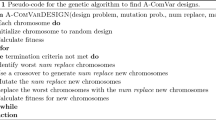Abstract
Two factorial designs with quantitative factors are called geometrically equivalent if the design matrix of one can be transformed into the design matrix of the other by row and column permutations, and reversal of symbol order in one or more columns. In this paper, we compare two known methods for the determination of geometric equivalence and propose a modified method based on the “split weights” of the rows of a design matrix. We also propose and evaluate new screening methods for geometric non-equivalence. Most of the paper concentrates on symmetric designs with factors at three levels, but extensions to designs with factors at four or more levels and to asymmetric designs are indicated.
Similar content being viewed by others
References
Ai, M.Y., Zhang, R.C., 2004. Projection justification of generalized minimum aberration for asymmetrical fractional factorial designs. Metrika 60, 279–285.
Chen, J., Sun, D.X., Wu, C.F.J., 1993. A catalogue of two-level and three-level fractional factorial designs with small runs. International Statistical Review 61, 131–145.
Cheng, S. W., Ye, K.Q., 2004. Geometric isomorphism and minimum aberration for factorial designs with quantitative factors. Ann. Statist. 32, 2168–2185.
Clark, J. B., Dean, A.M., 2001. Equivalence of fractional factorial designs. Statistica Sinica 11, 537–547.
Deng, L.Y., Tang, B., 2002. Design selection and classification for Hadamard matrices using generalized minimum aberration criteria. Technometrics 44, 173–184.
Draper, N.R., Mitchell, T.J., 1967. The construction of saturated 2Rk−p designs Ann. Math. Statist. 38, 1110–1126.
Draper, N.R. Mitchell, T.J., 1968. Construction of the set of 256-run designs of resolution ≥5 and the set of even 512-run designs of resolution ≥6 with special reference to the unique saturated designs. Ann. Math. Statist. 39, 246–255.
Draper, N.R., Mitchell, T.J., 1970. Construction of a set of 512-run designs of resolution ≥5 and a set of even 1024-run designs of resolution ≥6. Ann. Math. Statist. 41, 876–887.
Evangelaras, H., Koukouvinos, C., Dean, A.M., Dingus, C.A., 2005. Projection properties of certain three level orthogonal arrays. Metrika 62, 241–257.
Fontana, R., Pistone, G., Rogantin, M.P., 2000. Classification of two-level factorial fractions. J. Statist. Plann. Inf. 87, 149–172.
Hickernell, F.J., 1998. A generalized discrepancy and quadrature error bound. Math. Computation 67, 299–322.
Johnson, R.A., Wichern, D.W., 2002. Applied Multivariate Statistical Analysis, 5th edition. Prentice Hall, New Jersey.
Katsaounis, T.I., Dean, A.M., 2007. A survey and evaluation of methods for determination of combinatorial equivalence of factorial designs. J. Statist. Plann. Inf. In press.
Ma, C.X., Fang, K.T., Lin, D.K.J., 2001. On the isomorphism of fractional factorial designs. Journal of Complexity 17, 86–97.
MacWilliams, F.J., Sloane, N.J.A., 1977. The Theory of Error Correcting Codes. North Holland, Amsterdam.
Tang, B., 2001. Theory of J-characteristics for fractional factorial designs and projection justification of minimum G2-aberration. Biometrika 88, 401–407.
Xu, H., 2003. Minimum moment aberration for nonregular designs and supersaturated designs. Statistica Sinica 13, 691–708.
Xu, H., 2005. A catalogue of three-level regular fractional factorial designs. Metrika 62, 259–281.
Xu, H., Deng, L.Y., 2005. Moment aberration projection for nonregular fractional factorial designs. Technometrics 47, 121–131.
Ye, K.Q., 2003. Indicator function and its application in two-level factorial designs. Ann. Statist. 31, 984–994.
Author information
Authors and Affiliations
Corresponding author
Rights and permissions
About this article
Cite this article
Katsaounis, T.I., Dingus, C.A. & Dean, A.M. On the Geometric Equivalence and Non-equivalence of Symmetric Factorial Designs. J Stat Theory Pract 1, 101–115 (2007). https://doi.org/10.1080/15598608.2007.10411827
Received:
Revised:
Published:
Issue Date:
DOI: https://doi.org/10.1080/15598608.2007.10411827




